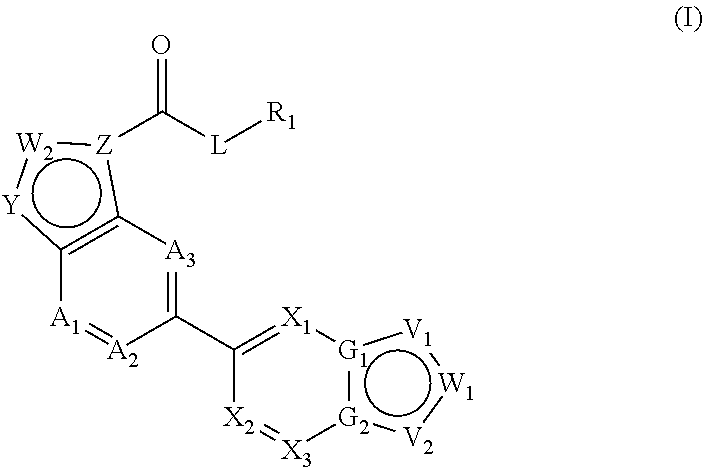Heteroaryl compounds as necrosis inhibitors, composition and method using the same
a technology of heteroaryl compounds and compositions, applied in the field of heteroaryl compounds, can solve the problems of necrosis, cytoplasmic and organelle swelling and eventual lysis of cells, inflammatory response, local or total cerebral ischemia and hypoxia, and achieve the effect of inhibiting necrosis
- Summary
- Abstract
- Description
- Claims
- Application Information
AI Technical Summary
Benefits of technology
Problems solved by technology
Method used
Image
Examples
example 1
C1
[0101]
Step 1: N-(6-bromo-1,3-benzothiazol-2-yl)acetamide (A1-1)
[0102]To a solution of 6-bromo-1,3-benzothiazol-2-amine (2.50 g, 10.7 mmol) and DMAP (1.33 g, 12.8 mmol) in CH2Cl2 (20 mL) was added slowly acetic anhydride (1.23 mL, 13.0 mmol) at 0° C. The mixture was stirred at room temperature overnight. Then the mixture was poured into 1N HCl solution, and the solids were collected via suction filtration. The solids were washed with water, dried to provide the title compound as a white solid (2.30 g, 79%). 1H NMR (400 MHz, CDCl3) δ 9.90 (br s, 1H), 7.94 (s, 1H), 7.61 (d, J=10.4 Hz, 1H), 7.54 (d, J=10.4 Hz, 1H), 2.30 (s, 3H).
Step 2: 7-bromo-1H-pyrido[2,3-b][1,4]oxazin-2(3H)-one (C1-1)
[0103]To a solution of 6-bromo-1H-pyrrolo[3,2-b]pyridine (97 mg, 0.5 mmol) in anhydrous THF (5 mL) was added slowly pyridine (120 mg, 1.5 mmol) followed by cyclohexyl carbonochloridate (162 mg, 1 mmol) in THF (2 mL). The mixture was stirred at room temperature for 3 h. The reaction was quenched by the ...
example 2
C2
[0105]
Step 1: cyclohexyl N-(2-amino-5-bromo-3-pyridyl)carbamate (C2-1)
[0106]To a solution of 5-bromopyridine-2,3-diamine (187 mg, 1.0 mmol) in anhydrous THF (5 mL) was added pyridine (160 mg, 2.0 mmol) at 0° C., followed by the addition of a solution of cyclohexyl carbonochloridate (162 mg, 1.0 mmol) in THF (2 mL). The mixture was stirred at room temperature for 3 h, and quenched with a saturated NaCl solution (20 mL). The aqueous layer was extracted with EtOAc (20 mL×3). Combined organic layers was dried and concentrated. The residue was purified by silica gel column chromatography (petroleum ether / ethyl acetate=10 / 1) to give the title compound as a colorless oily liquid (50 mg, 16%). 1H NMR (400 MHz, CDCl3) δ 7.98 (s, 1H), 7.81 (br s, 1H), 6.19 (br s, 1H), 4.81-4.69 (m, 1H), 4.52 (br s, 2H), 1.99-1.85 (m, 2H), 1.82-1.68 (m, 2H), 1.50-1.20 (m, 6H).
Step 2: cyclohexyl 6-bromoimidazo[4,5-b]pyridine-1-carboxylate (C2-2)
[0107]To a solution of C2-1 (47 mg, 0.15 mmol) in trimethoxymetha...
example 3
C3
[0109]
Step 1: Intermediate tetrahydropyran-4-yl carbonochloridate (B17-1)
[0110]To a solution of tetrahydropyran-4-ol (3.54 g, 24.7 mmol) and pyridine (2.74 mL) in CH2Cl2 (50 mL) was added slowly triphosgene (BTC) (4.04 g, 34.7 mmol) at room temperature. The mixture was stirred for 3 h and concentrated. EtOAc (100 mL) was added to the resulting residue, stirred at room temperature for 2 h, and the mixture was filtered. The filtrate was concentrated to give the title compound as a colorless oil (5 g, 90%).
Step 2: Intermediate 5-bromothiazolo[5,4-b]pyridin-2-amine (B31-1)
[0111]To a solution of KSCN (970 mg, 10.0 mmol) in acetic acid (2 mL) was added dropwise 6-bromopyridin-3-amine (348 mg, 2.0 mmol) at 0° C. and stirred for 5 min. A solution of Br2 (420 mL, 2.6 mmol) in acetic acid (1 mL) was added to the mixture at 0° C. The resulting mixture was stirred at room temperature overnight, filtered, and concentrated. The residue was neutralized with NaHCO3 solution and the aqueous layer ...
PUM
 Login to View More
Login to View More Abstract
Description
Claims
Application Information
 Login to View More
Login to View More - R&D
- Intellectual Property
- Life Sciences
- Materials
- Tech Scout
- Unparalleled Data Quality
- Higher Quality Content
- 60% Fewer Hallucinations
Browse by: Latest US Patents, China's latest patents, Technical Efficacy Thesaurus, Application Domain, Technology Topic, Popular Technical Reports.
© 2025 PatSnap. All rights reserved.Legal|Privacy policy|Modern Slavery Act Transparency Statement|Sitemap|About US| Contact US: help@patsnap.com



